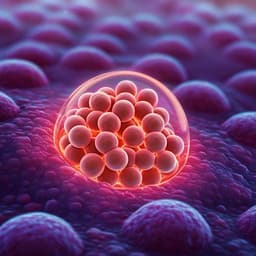
Engineering and Technology
An orange peel-based hydrogel composite for touch-responsive electronic skin
Z. Ran, J. Xu, et al.
This groundbreaking research by Zhuoqing Ran, Jie Xu, Wenyan Zeng, Yongping Leng, Bin Wu, Xueqing Zhan, Fang-Chang Tsai, and Ning Ma introduces an innovative e-skin made from eco-friendly hydrogel composites derived from freeze-dried orange peels. With exceptional self-healing properties, conductivity, and antibacterial effects, this material holds great potential for sustainable technological advancements.
Playback language: English
Introduction
The increasing global environmental concerns necessitate sustainable material production and waste management. Food waste, including edible fruit peels, poses a significant environmental challenge. This study addresses these issues by developing a novel electronic skin (e-skin) from readily available and sustainable resources: orange peels. E-skin, a crucial component of flexible electronic devices, aims to mimic the sensory capabilities of human skin, providing tactile feedback and acting as a human-machine interface. Current e-skin research often utilizes synthetic materials; however, the pursuit of biocompatible, biodegradable, and sustainable alternatives is a priority. Natural materials like starch, chitosan, cellulose, and hyaluronic acid offer promising properties for green e-skin development. Citrus peels, a major component of food waste, contain cellulose, pectin, and other compounds with potential for use in flexible sensors. Their utilization in e-skin creation would address both waste reduction and sustainable material development. To enhance the mechanical properties and biocompatibility of the orange peel-based e-skin, hyaluronic acid (HA), known for its biocompatibility and biodegradability, is integrated into the hydrogel. Polyvinyl alcohol (PVA), capable of hydrogen bond cross-linking, contributes to self-healing properties. Furthermore, the incorporation of a copper-based metal-organic framework (CuBDC) provides enhanced mechanical strength and antibacterial properties, creating a healthy environment for e-skin applications. The research focuses on synthesizing a PVA/HA/CuBDC/Mesocarp hydrogel composite using a simple and non-toxic method, evaluating its properties and demonstrating its potential for use in sustainable e-skin technology.
Literature Review
Existing literature highlights the evolution of electronic skin (e-skin) and the diverse mechanisms employed for its functionality, including piezoresistive, capacitive, triboelectric, and piezoelectric effects. The use of natural, flexible biomaterials like starch derivatives, chitosan, cellulose, hyaluronic acid, and alginates in green e-skin development is widely explored. Cellulose, with its dielectric, piezoelectric, degradable, and renewable properties, has shown significant potential as a dielectric layer, gel electrolyte, and substrate for e-skin. Studies have demonstrated the use of cellulose-based materials to improve the mechanical properties and biocompatibility of e-skins. The use of metal-organic frameworks (MOFs) in sensor applications is also well established, particularly regarding their role in microbial inhibition. Research indicates that metals such as copper, zinc, and silver exhibit antibacterial effects, enabling the creation of a 'healthy' environment for e-skin. Previous research has explored the integration of hyaluronic acid to enhance biocompatibility and biodegradability in hydrogel-based biomedical applications. PVA, known for its hydrogen bonding capabilities, has been utilized to promote self-healing properties in various materials. The synergistic combination of these materials in a single e-skin composite represents a significant advancement in the field.
Methodology
The research involved several key steps:
**1. Material Acquisition:** Orange peels were sourced from Yunnan Province, China. Polyvinyl alcohol (PVA), hyaluronic acid (HA), terephthalic acid (TA), copper(II) nitrate trihydrate, and dimethylformamide (DMF) were obtained from commercial suppliers.
**2. Mesocarp Powder Preparation:** The mesocarp (middle layer) of the orange peel was separated, air-dried, pulverized, and sieved through an 80-mesh sieve.
**3. CuBDC Synthesis:** CuBDC was synthesized using a hydrothermal method, involving the dissolution of copper(II) nitrate trihydrate and terephthalic acid in DMF, followed by hydrothermal treatment at 120 °C for 15 hours. The product was then purified, washed, and dried.
**4. Hydrogel Preparation:** Four different hydrogels were prepared: PVA/HA, PVA/HA/CuBDC, PVA/HA/Mesocarp, and PVA/HA/CuBDC/Mesocarp. Each hydrogel was synthesized by dissolving HA (and CuBDC in the relevant hydrogels) in water, adding PVA to this solution, and then performing a freeze-thaw cycle three times to enhance crosslinking and mechanical properties. The mesocarp was added to the respective hydrogels after the initial PVA/HA mixture had been subjected to two hours of mechanical stirring.
**5. Characterization:** The synthesized materials were extensively characterized using various techniques. Powder X-ray diffraction (PXRD) was used to analyze the crystalline structure of CuBDC. Liquid chromatography-mass spectrometry (LC/MS) determined the molecular mass of compounds in the orange peel. Fourier Transform Infrared (FTIR) spectroscopy and Attenuated Total Reflectance (ATR) investigated the chemical functional groups of CuBDC and the hydrogels, respectively. Scanning Electron Microscopy (SEM) imaged the microstructure of CuBDC and the hydrogel cross-sections. Thermogravimetric analysis (TGA) assessed the thermal stability of the hydrogels. Tensile and compression tests evaluated mechanical properties. Electrochemical workstation (CHI660e) measurements determined the conductivity of the hydrogels, followed by a calculation using the formula σ = d/(R × S). X-ray Photoelectron Spectroscopy (XPS) examined the valence states and interactions of surface elements. Dynamic Mechanical Analyzer (DHR) in time-scan mode assessed the viscoelastic properties. Antimicrobial properties were tested through bacterial growth experiments.
**6. E-skin Functionality Testing:** The e-skin's conductivity and strain sensitivity were measured, including gauge factor calculations, and repeated bending tests demonstrated its durability.
Key Findings
The synthesized PVA/HA/CuBDC/Mesocarp hydrogel demonstrated excellent properties suitable for e-skin applications. Characterization revealed:
* **Successful CuBDC Synthesis:** XRD, FT-IR, and SEM confirmed the successful synthesis of CuBDC with its characteristic two-dimensional nanosheet-like structure.
* **Hydrogel Structure:** SEM images showed a change in porosity with the addition of CuBDC and mesocarp, creating a more homogeneous and dense structure, indicating a strong interaction between components. FTIR spectroscopy showed a shift in peak positions, indicating the formation of hydrogen and ionic bonds.
* **Enhanced Mechanical Properties:** The PVA/HA/CuBDC/Mesocarp hydrogel exhibited significantly improved mechanical properties compared to the control (PVA/HA) hydrogel, with a maximum elongation at break of 290% and a maximum tensile stress of 0.3 MPa. This enhanced strength is attributed to the synergistic effects of hydrogen bonds, van der Waals forces, and ionic bonds between CuBDC and pectin from the orange peel.
* **Improved Conductivity:** The addition of CuBDC and mesocarp increased the hydrogel's conductivity (0.14 S/m), likely due to increased water absorption and pore density, facilitating the movement of ions.
* **Strain Sensitivity:** The hydrogel showed a stable and repeatable response to strain, with a gauge factor of approximately 3.1 in most strain regions and 5 around 80-100% strain, indicating its potential as a sensitive sensor.
* **Antibacterial Properties:** The hydrogel demonstrated substantial antibacterial activity, achieving a 95.3% reduction in bacterial colonies, attributable to the release of copper ions.
* **Self-Healing Capability:** The hydrogel exhibited effective self-healing properties, a consequence of the hydrogen bonding within the PVA matrix.
* **Practical Application:** The hydrogel's ability to successfully control a simple game (Flappy Bird) using its pressure sensitivity demonstrates its potential for real-world applications.
Discussion
This study successfully demonstrated the creation of a high-performance, sustainable e-skin material using waste orange peels. The incorporation of CuBDC enhanced mechanical strength and provided antibacterial properties, while the combination of PVA and HA ensured biocompatibility and self-healing capabilities. The superior mechanical and electrical properties achieved by the PVA/HA/CuBDC/Mesocarp hydrogel surpass those of many existing e-skin materials, making it a promising candidate for various applications. The findings address the research questions by showcasing a viable and eco-friendly approach to e-skin fabrication. The use of abundant and readily available waste materials significantly contributes to the sustainability efforts in material science. The high elongation at break, tensile stress, and conductivity demonstrate the material's suitability for wearable sensors and human-machine interfaces. The incorporation of CuBDC provides an additional advantage through its inherent antibacterial properties. This research opens new avenues for exploring similar approaches to utilize other forms of food waste in creating functional and sustainable materials.
Conclusion
This research successfully developed a novel electronic skin using a sustainable and environmentally friendly approach. The PVA/HA/CuBDC/Mesocarp hydrogel demonstrated superior mechanical properties, conductivity, and antibacterial effects, making it a promising candidate for wearable sensor applications. This work highlights the potential of utilizing food waste to create high-performance materials, contributing to both sustainability and technological advancements. Future research could focus on optimizing the hydrogel composition, exploring different types of fruit peels, and investigating the long-term stability and biodegradability of the material in various environments.
Limitations
While the study demonstrates the potential of the orange peel-based hydrogel, several limitations exist. The study focused primarily on laboratory-scale synthesis and characterization. Further research is required to evaluate the material's long-term stability and biodegradability in real-world conditions. Scalability of the production process and cost-effectiveness need further investigation for potential commercialization. Additional testing is needed to fully evaluate the e-skin’s performance under varied environmental conditions and with different types of strain. The scope of antibacterial testing could be expanded to include a wider range of microorganisms.
Related Publications
Explore these studies to deepen your understanding of the subject.







